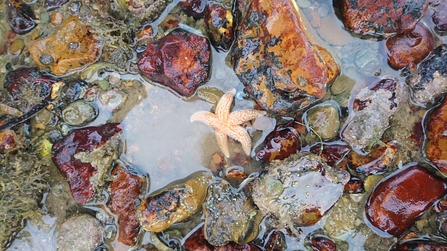Somewhat belatedly, I am discovering that there is much more to the Isle of Wight than I ever realised growing up here. Thanks to my experience on an intertidal survey, I find that this also includes our seashores. I was a little concerned that I hadn't spotted much wildlife when swimming in the sea over the last year, but now I realise that I was just looking in the wrong place. The sandy stretches preferred by the swimmer tend not to attract many plants and animals, but if you look in the right areas the shore is still teeming with life.
I joined my first survey at Thorness Bay, slightly apprehensive about being wildly ignorant about coastal wildlife. I'd brought a guidebook as suggested but wasn't sure I'd even know where to start looking in it. Thankfully, I wasn't the only newbie there, and we were all partnered with people who were much more experienced, so I needn't have worried! After a thorough briefing by our enthusiastic and knowledgeable leader, Emily, we trooped off along the beach to find the location of previous surveys.
At first it didn't look very hopeful, there wasn't much to see as we walked to our starting point. However, it became clear that timing as well as location is critical, as we arrived the outgoing tide began to reveal expanses of rock and seaweed that looked much more promising. We gathered into our little teams and started recording everything we found. The most obvious finds were the many and varied seaweeds (previously just lumped into a single category in my mind). But as people looked patiently and closely, carefully lifted rocks and moved seaweed aside, all sorts of things emerged.
Native oysters were apparently a significant find. In times past the Solent was thick with them, it was once Europe’s largest self-sustaining native oyster fishery, but saw massive decline due to overfishing and environmental factors. Pacific oysters were introduced in their place, and are a more common find today, but restoration efforts are underway to reintroduce the native species so Emily was excited that we turned up several live native oysters during the survey (dead wildlife unfortunately doesn't count). Also pleasing was a new seagrass bed that we discovered. Seagrass is hugely important to a thriving ecosystem and is an excellent carbon sink but has also been in decline. Efforts to bring it back are clearly working here.
I couldn't tell you all the species we found, but there were several crab species, sea lemons, sea squirts (new to me, a sea squirt! Wonderful) and all sorts of other things. I wasn't great at spotting but was able to bask in the better abilities of more experienced surveyors, some of whom were just amazing at turning things up where there appeared to be nothing. I did, however, find the only starfish of the day, which even I couldn't miss (see below).


